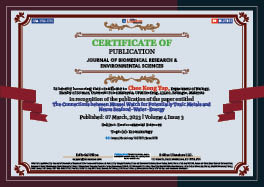Chee Kong Yap*, Hideo Okamura, Yoshifumi Horie, Meng Chuan Ong, Ahmad Dwi Setyawan, Hesham MH Zakaly, Rosimah Nulit, Wan Mohd Syazwan, Krishnan Kumar, Wan Hee Cheng, Muhammad Saleem, Abolfazl Naji, Mohamad Saupi Ismail, Moslem Sharifinia, Mehrzad Keshavarzifard and Chee Wah Yap
Volume4-Issue3
Dates: Received: 2023-01-31 | Accepted: 2023-03-06 | Published: 2023-03-07
Pages: 317-320
Abstract
The previous assessment intends to support the inaugural International Mussel Watch program's use of marine mussels as biomonitors of potentially toxic metals in aquacultural areas has been considered of low novelty even though it is a necessary biomonitoring. When it is looked into the connections between Mussel Watch and Nexus seafood-water-energy, the questions can be raised up because there is apparently no such discussion in the literature. Therefore, the objective of this review is to discuss the connections between Mussel Watch for potentially toxic metals and Nexus seafood-water-energy, based on the topic reported in the literature separately. The current short review can act as a springboard for additional insights to offer fresh perspectives and original suggestions on using marine mussels more effectively in biomonitoring investigations in connections to Nexus seafood-water-energy. Nowadays, the biomonitoring by using Mussel Watch has remained effective and sustainable which further highlighted their importance in pollution monitoring. The likelihood of improved and wider-ranging molluscan uses in environmental monitoring in the future is almost inevitable. However, more research is still needed to address the rising demand in line with sustainable, attainable United Nation Sustainable Development Goals (‘‘Responsible consumption and production’’, and ‘Good Health and Well-beings’). This is surely a major player in the Nexus’s seafood in cycle with water and energy that should be addressed in future biomonitoring studies.
FullText HTML
FullText PDF
DOI: 10.37871/jbres1678
Certificate of Publication

Copyright
© 2023 Yap CK, et al. Distributed under Creative Commons CC-BY 4.0
How to cite this article
Yap CK, Okamura H, Horie Y, Ong MC, Setyawan AD, Zakaly HMH, Nulit R, Syazwan WM, Kumar K, Cheng WH, Saleem M, Naji A, Ismail MS, Sharifi nia M, Keshavarzifard M, Yap CW. The Connections between Mussel Watch for Potentially Toxic Metals and Nexus Seafood-Water-Energy. 2023 Mar 07; 4(3): 317-320. doi: 10.37871/jbres1678, Article ID: JBRES1678, Available at: https://www.jelsciences.com/articles/jbres1678.pdf
Subject area(s)
References
- Zuykov M, Pelletier E, Harper DA. Bivalve mollusks in metal pollution studies: from bioaccumulation to biomonitoring. Chemosphere. 2013 Sep;93(2):201-8. doi: 10.1016/j.chemosphere.2013.05.001. Epub 2013 Jun 14. PMID: 23751124.
- Goldberg ED. The mussel watch: A first step in global marine monitoring. Mar Pollut Bull. 1975;6:111. doi: 10.1016/0025-326X(75)90271-4.
- Yap CK, Sharifinia M, Cheng WH, Al-Shami SA, Wong KW, Al-Mutairi KA. A Commentary on the Use of Bivalve Mollusks in Monitoring Metal Pollution Levels. Int J Environ Res Public Health. 2021 Mar 25;18(7):3386. doi: 10.3390/ijerph18073386. PMID: 33805997; PMCID: PMC8061770.
- Boening DW. An evaluation of bivalves as biomonitors of heavy metals pollution in marine waters. Environ Monit Assess. 1999;55:459-470. doi: 10.1023/A:1005995217901.
- CDCP Third National Report on Human Exposure to Environmental Chemicals. Department of Health and Human Services Centers for Disease Control and Prevention. Atlanta, Georgia, USA. 2005.
- Yap CK, Ismail A, Tan SG. Biomonitoring studies of the west coast of peninsular Malaysia using the green-lipped mussel Perna viridis: Present status and what next? Pertanika J Trop Agric Sci. 2004;27:151-161.
- Phillips DJH. Quantitative Aquatic Biological Indicators. Pollution Monitoring Series. Netherlands: Springer; 1980.
- Farrington JW, Goldberg ED, Risebrough RW, Martin JH, Bowen VT. U.S. "Mussel Watch" 1976-1978: an overview of the trace-metal, DDE, PCB, hydrocarbon and artificial radionuclide data. Environ Sci Technol. 1983 Aug 1;17(8):490-6. doi: 10.1021/es00114a010. PMID: 22283169.
- Tanabe S. International mussel watch in Asia-Pacific phase. Mar Pollut Bull. 1994;28:518. doi: 10.1016/0025-326X(94)90057-4.
- Liu G, Arthur M, Viglia S, Xue J, Meng F, Lombardi GV. Seafood-energy-water nexus: A study on resource use efficiency and the environmental impact of seafood consumption in China. J Cleaner Prod. 2020;277:124088. doi: 10.1016/j.jclepro.2020.124088.
- Orimoloye IR. Water, energy and food nexus: Policy relevance and challenges. Front Sustain Food Syst. 2022;5:824322. doi: 10.3389/fsufs.2021.824322.
- Zhu Q, Sun C, Zhao L. Effect of the marine system on the pressure of the food-energy-water nexus in the coastal regions of China. J Cleaner Prod. 2021;319:128753. doi: 10.1016/j.jclepro.2021.128753.
- Lai Q, Ma J, He F, Zhang A, Pei D, Yu M. Current and Future Potential of Shellfish and Algae Mariculture Carbon Sinks in China. Int J Environ Res Public Health. 2022 Jul 21;19(14):8873. doi: 10.3390/ijerph19148873. PMID: 35886723; PMCID: PMC9322719.
- Bai X, Fu Z, Li N, Stankovski S, Zhang X, Li X. Water environmental nexus-based quality and safety risk assessment for fish (Carassius auraus) in aquaculture. J Cleaner Prod. 2021;288:125633.
- Yap CK, Ismail A, Edward FB, Tan SG, Siraj SS. Use of different soft tissues of Perna viridis as biomonitors of bioavailability and contamination by heavy metals (Cd, Cu, Fe, Pb, Ni, and Zn) in a semi-enclosed intertidal water, the Johore Straits. Toxicol Environ Chem. 2006;88(4):683-695. doi: 10.1080/02772240600874139.
- Yap CK. Mussel watch in Malaysia past, present and future. Serdang, Malaysia: UPM Press; 2012.
- Yap CK, Ismail A, Tan SG. Background concentrations of Cd, Cu, Pb and Zn in the green-lipped mussel Perna viridis (Linnaeus) from Peninsular Malaysia. Mar Pollut Bull. 2003 Aug;46(8):1044-8. doi: 10.1016/S0025-326X(03)00163-2. PMID: 12907200.
- Shahbazi A, Zakaria MP, Yap CK, Tan SG, Surif S, Mohamed AR, Sakari M, Bakhtiari AR, Bahry PS, Chandru K, Mirsadeghi SA. Use of different tissues of Perna viridis as biomonitors of polycyclic aromatic hydrocarbons in the coastal water of Peninsular Malaysia. Environ Forensics. 2010;11:248-263. doi: 10.1080/15275920903558513.
- Zulkifli SZ, Ismail A, Mohamat-Yusuff F, Arai T, Miyazaki N. Johor strait as a hotspot for trace elements contamination in peninsular Malaysia. Bull Environ Contam Toxicol. 2010 May;84(5):568-73. doi: 10.1007/s00128-010-9998-8. Epub 2010 Apr 22. PMID: 20411236.
- Keener L. Food Safety Objectives: The Nexus among Preventive Controls, Validation, and Food Safety Assurance. Food Safety Magazine. 2022.






























































